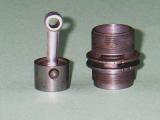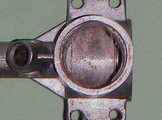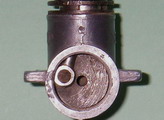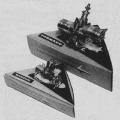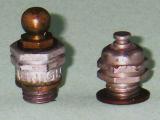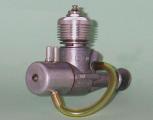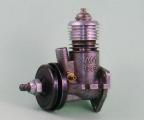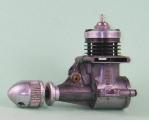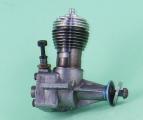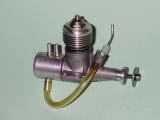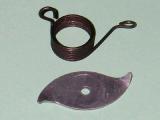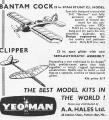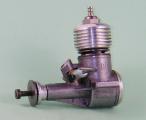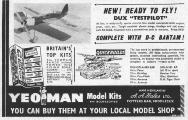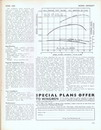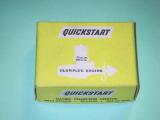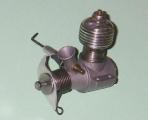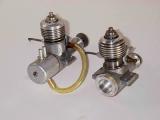DC Bantam
A Lost Opportunity
by Adrian Duncan
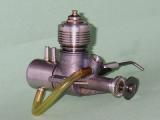 |
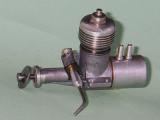 |
|
| Click on images to view larger picture. | ||
In a the KeilKraft Cobra review, we covered the British 1/2A glow motor "revolution" of 1959/60 in some detail. Here we take an up-close and personal look at the engine by which that movement is perhaps best remembered—the D-C Bantam. It turns out that the story of this little unit is far more interesting than might at first be supposed!
The D-C Bantam was a popular 0.76 cc glow-plug motor manufactured by Davies-Charlton Ltd on the Isle of Man between late 1959 and 1971. At the time of its introduction it was highly touted as the British response to the challenge of the American-made 1/2A glows which were then reaching Britain in ever-increasing numbers. Would that the response had been a little more vigorous.
Description
Although very well made where it counted, the Bantam was most definitely designed down to a price and was the least expensive model IC engine ever sold in Britain at the time of its release. It almost certainly still holds this record today. To save on development and production costs, it was designed around the existing Mk II Dart 0.55 cc diesel crankcase and used broadly similar porting arrangements.
Basing a glow-plug motor upon an existing diesel, however good, is seldom the most effective approach in performance terms—what works well using one form of ignition rarely transfers as effectively to the other. However, it is the cheap way to go in terms of the required development and tooling investment, and the Bantam was unquestionably designed from the outset with a low selling price as the primary objective.
The Bantam had the same stroke as the Dart and achieved its extra displacement solely through a bore increase. Bore of the Bantam was 10.41 mm as opposed to the Dart's 8.94 mm. Both had a stroke of 8.94 mm resulting in a displacement for the Bantam of exactly 0.76 cc (0.046 cuin), somewhat below the prevailing American 1/2A displacement limit of 0.050 cuin. This implies that the engine was aimed primarily at the domestic sport-flying market and indeed it does not appear to have sold in great numbers in North America where 1/2A motors having far higher performance were readily available.
The bare weight was a very light 1.3 ounces, or 1.5 ounces with tank. Some of this was accounted for by the fact that the Bantam was equipped with Davies-Charlton's Quickstart spring starting device. If ever there was an engine that didn't need this silly piece of equipment, it was the Bantam! The engine was so docile and so easy to flip over that the use of a starter of any kind was quite unnecessary and merely added bulk, dead weight, cost and complexity for no benefit. Most users removed this clobber right away.
Like its Dart progenitor, the Bantam used a screw-in cylinder featuring radial porting. However, while the Mk II Dart's transfer system had incorporated three angled holes fed by external bypass flutes formed in the outer wall of the lower cylinder, the Bantam employed three sawn slots each for both exhaust and transfer. Generally speaking, the use of this type of porting is cost-effective in production terms but has the great disadvantage of delaying transfer until the exhaust is fully open. The net result is some compromise between an exhaust that opens too early, or a transfer that opens too late.
It was for this reason (among others) that the use of such porting had been discarded by the more progressive glow-plug motor designers as of 1959. In the case of the Bantam with its very short stroke, the practical result was that the transfer period was unusually restricted despite the exhaust ports opening relatively early during the power stroke.
Apart from the use of sawn slots instead of drilled holes for the actual transfer ports, the bypass arrangements actually owed much to the earlier OK engines from the USA and were essentially identical to those used on the contemporary Wen-Mac and AM .049 models. An unthreaded internal portion of the upper crankcase boss combined with a similarly unthreaded portion of the outer cylinder wall to form in effect a 360 degree unthreaded annular passage around the cylinder at transfer port level. This annular volume was fed from the lower crankcase by two milled bypass passages, one on each side, which interrupted the female threads into which the cylinder screwed.
During the transfer cycle, gas flowed up these two passages into the annular passage surrounding the cylinder and thence into the cylinder itself through the three transfer slots. The system had the advantage that transfer efficiency was relatively unaffected by the radial alignment of the screw-in cylinder when tightened down. It did however result in a somewhat convoluted transfer gas pathway.
The aluminium alloy cooling jacket screwed onto the externally threaded upper portion of the cylinder in the conventional manner. The jacket also incorporated the cylinder head and was centrally drilled and tapped for a short-reach glowplug. It sealed to the top of the cylinder with a relatively thick gasket. Compression ratio was very low, even by 1/2A glow standards. This is odd given the low-nitro fuels then in common use on Britain, where nitromethane was prohibitively expensive. The Bantam actually needs a fair dose of nitro to deliver anything like a useable performance.
The one-piece hardened steel crankshaft featured a simple plain disc crankweb, no counterbalance of any sort being provided. The shaft was drilled and tapped at the front end to accommodate the rather skimpy 6 BA prop mounting screw. Induction was controlled by the common crankshaft front rotary valve (FRV) system. The Bantam used a very skinny shaft for an FRV engine of its displacement—journal diameter was only 0.205 inch. Strength considerations restricted the diameter of the internal gas passage to a mere 0.100 inch. The actual crankshaft induction port was a simple round hole having a diameter of 0.107 inch. This was supplied with mixture through a venturi having a throat diameter of 0.167 in.
In summary, the Bantam was in effect an over-bored Dart using glow-plug ignition and having a somewhat simplified transfer system. Let's now see how it fared in the media and in the marketplace.
Introduction and Test Controversy
The Bantam was released in prototype form to selected reviewers like Peter Chinn and Ron Warring in August 1959. Chinn published a description of this prototype in the October 1959 issue of Model Aircraft. The engine finally appeared in production form in November 1959, just in time for the Christmas rush. At a selling price of a mere �1 14s. 6d (say £1 73p in the new money), it was the most inexpensive engine that had ever been offered to the British modelling public and handily undercut all of the competition.
The Bantam had actually been preceded into the British marketplace by the rival Frog .049 (July 1959) and A-M .049 (September 1959). This did not prevent it from making an immediate impression upon the British modelling scene.
The release of the Bantam coincided with a quite marked shift in the marketing approach taken by D-C Ltd. In July of 1959 the company had released their "Quickstart" spring starter device and had adopted the "Quickstart" trade-name and associated logo to be applied to their products thenceforth. The Bantam was in fact promoted as the "Quickstart" Bantam from the outset. A completely new and quite unusual triangular box was also developed, and the Bantam was initially sold in this rather striking form of packaging.
And it didn't stop there—together with IMA and A-M, D-C Ltd were instrumental in persuading the long-established KLG firm to update their well-entrenched "Miniglow" glow-plug design. The result was the "Miniglow X" plug which was featured in all of the British .049 glow-plug models apart from the Cobra .049 with its Cox-influenced glow head.
The widely-heralded introduction of the Bantam attracted a great deal of modeller interest, and Aeromodeller magazine hastened to scoop the review of the new engine. They did so in the most emphatic manner by putting it up against two competing British .049 glow-plug motors from Allen-Mercury and Frog in an unusual triple engine test. It received a glowing accolade from tester Ron Warring in his January 1960 report.
The timing was perfect—glow-plug ignition was just beginning to make serious inroads into the former supremacy of diesels in Britain, and small glow-plug engines were the fad of the day. The stage was well set for a most favorable reception for a new British 1/2A glow model. Warring's published test figures of 0.053 BHP @ 15,000 rpm compared well with reported figures for other competing models, both diesel and glow, and the price was most attractive also. It seemed that a new star was in the ascendant!
So far so good, but now it becomes interesting—there was a very large fly swimming around in this particular ointment! The first indications of this were detected by the many modellers who had rushed out to buy the new wunderkind of the model engine world. Try as they would, they couldn't get the engine to deliver anywhere near the levels of performance that Warring's test suggested that it should. There was a great deal of puzzlement over this; what was going on?
The issue was underscored by the appearance of a test by Peter Chinn which was published in the March 1960 issue of Model Aircraft. In that test, Chinn obtained far less spectacular results than Warring had done—he was only able to extract a peak of 0.035 BHP @12,600 rpm—a 33% shortfall in peak output at some 2,400 fewer rpm! Oops! Talk about a reality check! Even the smaller Dart diesel did better than that. Chinn was far more cautious than Warring had been in singing the engine's praises—he described the performance as "adequate".
Now a review of the performance figures presented in the series of engine tests attributed to Chinn and Warring in their respective magazines over the years shows that for the most part Chinn tended to find more power and somewhat higher peaking speeds than Warring for the same engine. This was presumably due to variations in engine management and testing techniques. We hope to publish an analysis of this finding at some point in the future.
For now, what can be said is that the observed discrepancy between the results obtained by Chinn and Warring for the Bantam runs directly counter to the general observation noted above and is moreover of a magnitude that cannot be simply explained by variations in testing techniques, nor indeed by incidental differences between examples of the same design.
The most direct evidence of this discrepancy is found in the published rpm figures for the supposedly matching Davies-Charlton nylon props which should have been independent of testing techniques given the fact that both testers used the manufacturer's recommended "Quickstart" glow fuel. Warring reported figures of 14,200 rpm and 17,600 rpm for the D-C nylon 6x4 and 5-1/2x3-1/2 airscrews respectively while Chinn could only manage 12,200 rpm and 14,500 rpm on the same very "fast" props. Since horsepower varies as the cube of the speed for the same prop, this represents a very significant power differential.
Fortunately, Chinn's characteristically detailed test report included what I believe to be the explanation of this anomaly. He stated that the production model covered in his report differed in a number of details from the original pre-production test engine which Chinn had described in the October 1959 issue of Model Aircraft. Firstly, he noted that the crankcase of the test engine had only one bypass passage instead of two, although the unthreaded annular passage surrounding the cylinder at transfer port level had been enlarged. Here I can only comment that all of the examples which I have inspected internally have had two bypass passages, indicating either that Chinn's test engine had a manufacturing flaw (not uncommon with D-C engines at this time) or that the company quickly reverted to the twin bypass passages in light of Chinn's published findings.
In any case, that alone would not account for the observed performance discrepancy. Of far greater import were the changes described by Chinn to the induction arrangements. He noted that the original prototype had a rectangular shaft induction port, which would give far more rapid opening and closing of the induction system than the simple round hole which replaced it in the production version. Even more significantly, the diameter of the internal gas passage had been reduced from 5/32 in (0.156") in the prototype to 3/32 in (0.094") for the production version, a whopping reduction of some 64% in area.
Here I must interject again and report that all of the shafts checked by myself personally have had internal gas passage diameters of 0.100 in, indicating that the original reduction was likely made for strength reasons (presumably they had a rash of broken shafts of the original prototype style) and that they restored as much lost diameter as they dared when the effect on performance of the full reduction became apparent. Perhaps they also restored the second bypass passage for the same reason, assuming that Chinn's example was not representative of a manufacturing omission.
There were a few other changes of a minor nature, none of which would have affected performance. However, the changes described above are quite sufficient to confirm that the performance of the original prototypes would have greatly exceeded that of the production version tested by Chinn.
In this context, it's noteworthy that Warring's test example must have been in his hands by November of 1959 at the very latest in order to allow for the concurrent tests to be carried out on the Bantam and the other two engines in time to meet the editorial deadline for the January 1960 publication of the triple test. I believe that this is the explanation of the mystery—Warring tested one of the original prototypes, while Chinn tested the production version which had a greatly de-rated performance, largely as a result of the modifications to the crankshaft.
Warring unfortunately did not describe the shaft of his engine in sufficient detail to confirm that it was of prototype pattern, but all the evidence points that way. Apart from the measured performance, his example certainly had the twin bypass passages in the case—he said as much. In addition, the fact that Warring confirmed that his example had a fully floating gudgeon pin clearly implies that it was a prototype model. One of the changes specifically described by Chinn was a switch from a fully floating gudgeon pin in the prototype to a pressed-in item in the production version of the Bantam.
It was in fact very "convenient" for Davies-Charlton that Warring's report made it into print two months prior to Chinn's far more representative analysis. Warring's extremely positive test report was received with great enthusiasm, and everyone immediately rushed out to buy a Bantam, however the more discriminating buyers soon became aware of the fact that examples as good as the one that Warring tested appeared to be scarcer than sealions in the Sahara! Most of those that found their way into the hands of modellers (and there were a lot of them) quickly proved themselves to be gutless wonders, albeit very light, compact, easy starting and well made. There was much puzzlement; I remember it well!
The appearance of Chinn's test in March of 1960 set the record straight with a vengeance! The performance of his test engine was much more in line with what users were experiencing than that extracted by Warring, whose reputation as a tester took a bit of a knock over this, as I recall from flying field discussions at the time. There were dark mutterings about Warring having been "on the take". I don't recall anyone at the time (myself included) picking up on Chinn's comments and coming to the fairly obvious conclusion that Warring must have tested one of the prototypes.
If there was one person who must surely have come to this conclusion immediately upon reading Warring's test report, it was Hefin Davies of Davies-Charlton. He at least must have realized right away that Warring's results were in no way representative of those to be expected from the production version and that they must surely pertain to D-C's very different pre-production prototypes rather than to the engines which were then leaving the factory in very large numbers. The fact that Davies-Charlton apparently took no steps to set the record straight or encourage Warring to do so is hardly a positive reflection of Davies' commitment to ethical business practices.
For me, the unanswered question remains—did Warring knowingly test a prototype having superior performance and present it as a production model, thus conspiring with the manufacturers in an effort to inflate the engine's performance potential? Alternatively, was he "set up" by Davies-Charlton through being supplied with a prototype in the guise of a production unit or by not being informed of the changes to the production model and thus believing his prototype example to be representative of those being sold? The fact that Warring didn't describe the induction arrangements incorporated in the shaft implies that there may have been "something to hide" in that area and that Warring may have gone along with some form of subterfuge, but we can't say this for sure. Nevertheless, the doubt remains. Personally, I'd far rather believe in the set-up theory!
Although the beginners and sport fliers who undoubtedly made up the majority of Bantam owners probably neither noticed nor cared, the sense of let-down among the more serious and experienced modellers was quite palpable at the time, and the Bantam probably did more to turn the tide of prejudice against British .049 glows among serious modellers in Britain than any other engine. It also didn't do any favors to Davies-Charlton's reputation among the cognoscenti.
Personal Recollections of the Bantam
At the time of the Bantam's release, I was an impecunious twelve year old schoolboy living in Sheffield, England and flying smaller models simply because I could more or less afford to keep them supplied with fuel! As of early 1960 I had an ED Bee (who didn't?!), a beat-up Frog 80 Mk I and a ratty but still very serviceable Allbon Merlin. I was happy with these little diesels, but nonetheless wanted to try a glow. I didn't like the radial mounts and bulky back tanks on the then-current Cox .049 models, so when a rash of beam-mounted British 1/2A glow models started appearing in mid 1959, I sat up and took notice.
That January 1960 Aeromodeller test was quite an event—three motors tested in one issue! I looked at the A-M .049, which was in effect a Wen-Mac clone—hated that cumbersome starter and Mickey-mouse needle valve plus the inconvenient beam mounts. As a present-day collector, I now own several of these engines, but back then when it counted I wasn't interested. Neither was anyone else—the A-M didn't last long, hence its present-day rarity.
I then looked at the Frog .049, which was basically a glow conversion of the Frog 80 diesel—too bulky, besides which it didn't get near the diesel version for performance and I already had an 80 diesel. No dice. Although I have since acquired an example for my collection. A really nice runner but pretty gutless, especially for its bulk, and not a patch on the diesel version in performance terms. The modellers of the early sixties agreed with this assessment and stayed away in droves, hence the relative present-day rarity of this engine as well.
I was also aware of the Cobra .049 thanks to its rather premature late 1959 appearance on the plan of the KeilKraft "Firefly" control line stunt model. This one really interested me, however the Cobra signally failed to make an appearance in model shops in my area and increasingly took on the appearance of a rumour rather than an actual production! It did make it onto the market later in 1960, but didn't last long and never appeared in any of my local model shops. A great pity, because it was in many ways the best of the Brit 1/2A glow-plug models.
Then I looked at the Bantam! "Aha!" I thought, "Here's Britain's answer to the American .8 cc onslaught!" So I did odd jobs, saved my pocket money and eventually scraped together the modest cost of a very slightly used Bantam. Low cost was one of its four positive attributes—it was cheap! The other three were that it was very light and compact; it was quite well made; and it started very easily. End of positives  .
.
I never stopped to wonder why this relatively new Bantam was going so cheap after having been barely used but I soon found out! First thing I did was remove the Quickstart clobber—ugly as hell, added bulk and dead weight and was completely unnecessary. Most owners did the same. The Bantam was a dead easy starter by any standard, and I soon had it running without that silly spring.
At that point, I was astonished at the sight of mosquitoes making headway flying upwind in the slipstream from the supposedly matching D-C 5-1/2x3-1/2 nylon prop! Warring had reported getting the thing up to 17,600 rpm on that prop, but using the harmonica which then served me as a rev counter (you matched the note and hence the frequency), the best I could do was a sharpened B flat—somewhere in the vicinity of 14,000 rpm. Quite a discrepancy. And that particular prop was designed to let engines rev, not to move air, so there wasn't much happening, and with a "real" prop, the engine just died!
Now it's quite possible that mine was a particularly bad example, but I recall a lot of others having similar reactions. The things were so unbelievably gutless that there was a general sense of let-down among the active modelling crowd and the muttering soon started. I recall most of the keener flyers very quickly giving up on their Bantams in disgust when they found out how anaemic they really were. Certainly, my faithful old Allbon Merlin and Frog 80 diesels would bury my Bantam any day! In fact, based on my own experiences I reckon the average housefly could out-pull a typical Bantam.
The word soon got about and Chinn's belated test report confirmed everyone's observations. I think this debacle really did harm the image of the British industry in general and D-C Ltd in particular. The Bantam became a bit of a standing joke among serious modellers, in fact—an under-performing engine of any sort in any model would draw comments like "What have you got in that—a Bantam or something?" The Bantam thus moved into the position formerly held (rather undeservedly, in my book) by the ED Bee!
A few kit manufacturers got onto the Bantam bandwagon by releasing kits specifically tailored to the Bantam. Notable among these was AA Hales, who released the Bantam Cock stunt control-liner in early 1960 under their in-house "Yeoman" brand. I must confess to having built a Bantam Cock for my own Bantam using a borrowed plan (couldn't afford the kit—sorry, Yeoman). It got the very light model into the air, but was pretty marginal for aerobatic performance.
That was pretty much it for many years with the Bantam apart from a brief stint in a sport free flight cabin model (in which the Bantam performed well)—I went back to the dear old Merlin and Frog (both far superior engines) and soon graduated to larger engines and models in any case.
The Bantam Re-evaluated
In my book, the Bantam represents an instructive example of lost opportunity. Having acquired some understanding of engine set-up and tuning during the years following my introduction to the Bantam, I finally decided to test this notion by seeing just how well a Bantam could be made to run. So I dug my still serviceable original 45 year old Bantam out of its drawer to have a good look at it in the light of later experience.
It was clear that the single most limiting factor in the engine's design was the induction system, which was positively asphyxiating! To start with, you had that tiny 0.100 in dia. gas passage in the shaft—unavoidable because the shaft journal itself was pretty skinny at only 0.205 in dia. However, the very small crankcase volume meant that things might not have been so bad if gas had been able to get into the gas passage from the venturi! Problem there was that the tiny 0.107 in diameter induction port in the shaft surface was way smaller than the venturi internal diameter of 0.167 in. and thus represented a major discontinuity and hence a significant constriction to gas flow. Plus both venturi and induction port were round holes, which gives relatively slow (and hence inefficient) opening and closing of the induction system.
It's obvious in hindsight that the original shaft with its rectangular induction port and substantially larger internal gas passage would have yielded far superior performance figures along the lines of those measured by Warring. However, it appears that experience with shaft breakages must have dictated the reduction in the size of the gas passage—the fact that D-C were tied by cost considerations to the used of the Dart crankcase and crankshaft tooling excluded the possibility of an increase in the shaft diameter. Cost considerations also doubtless led to the abandonment of the more efficient rectangular shaft port in favour of a simple drilled hole as used in the Dart.
I don't normally recommend modifying old engines, but in the case of the odd Bantam I'm prepared to make an exception—there are a lot of them around, and at least they then become worthwhile engines to actually use! I see merit in that—I'd rather have a few of them in the air than simply resting in attics, collections or dustbins! That said, I still stop short of recommending any externally-visible mods—it ain't a Bantam unless it looks like a Bantam!
As one might expect from the earlier comments, the most important modifications relate to the crankshaft. The greatest single improvement is achieved by elongating the induction port in the shaft in a fore-and-aft direction using a small Dremel grinding stone. You don't want to change the timing by widening the port—the timing is pretty good, added to which you'll further weaken the already-skimpy shaft. The aim is to turn it from a round hole into an oval "race-track" shape running fore and aft with its ends extending just beyond the front and rear edges of the venturi when the shaft is pulled forward into its normal running location. It's also good to undercut the induction port slightly towards the crankweb to ease the right-angled bend around which the incoming gas has to pass.
Done correctly, the effect of this is to significantly increase the rate of opening and closing of the induction system while leaving the induction timing of the engine unchanged and not weakening the shaft unduly. Put another way, the system is open for the same period of crankshaft rotation but becomes fully open much faster and remains fully open significantly longer. There is also far less of a gas flow constriction at the point of intersection between the venturi base and the crankshaft induction port.
I also added two short flow channels radiating from the central gas passage at 90 degrees to each other in the rear face of the crank disc to help gas to escape from the shaft interior during the period around bottom dead centre when it's largely blocked by the con-rod while transfer of gas is still taking place. These were symmetrically arranged on the opposite side of the gas passage from the crankpin so that at bottom dead centre they fed upwards at 45 degrees, one to each side of the rod. Finally, I ground a little metal off the rim of the crank disc on both sides near the crankpin (taking great care not to damage the pin!) to add some counterbalance. Probably not strictly necessary with an engine of this displacement, but every little bit helps!
All of this has to be done with great care, and should only be attempted if you really know what you're doing—mess it up and you've wrecked the shaft. Also, do not overdo it, or you'll weaken the shaft to the point where it may break. The material is hardened, so grinding is the only approach that works.
Turning to other components, I replaced the rear cover gasket (a ridiculously thick fibre component) with a far thinner treated paper gasket which moved the backplate further into the case when tight (there's ample clearance for the rod and shaft) and reduced crankcase volume still further for better pumping efficiency.
One area in which some Bantams suffer greatly is that of cylinder distortion when the cylinder is tightened down hard, as it has to be to prevent unscrewing while running. This is a chronic problem with relatively thin cylinders assembled by screwing into the case, and is particularly aggravated when the female threads into which the cylinder screws are interrupted by gas passages, as in the Bantam. The interrupted threads naturally cause the thread forces to be applied unevenly around the circumference of the lower cylinder. With a thick lower cylinder this is OK, but with a thin cylinder like that in the Bantam it can be problematic.
There's only so much that can be done about this. The most important thing is to ensure that the deck (the upper surface of the crankcase boss onto which the cylinder flange seats) is perfectly at right angles to the cylinder installation thread and is also dead flat. As delivered, some examples were neither. Sorting this is a skilled task, the details of which are beyond the scope of this article. Suffice it to say that if the deck is made true and flat (taking minimal metal off while doing so), cylinder hold-down stresses are better distributed and cylinder distortion problems are largely eliminated. A thin treated paper gasket is used to provide a seal at the cylinder base.
It's also possible to improve transfer efficiency to some degree by externally chamfering the edges and lower lip of the cylinder transfer slots to ease the movement of gas from the annular distribution passage in the case to the actual transfer slots themselves. Again, this is a skilled task which has to be carried out by grinding and should only be attempted if you really know what you're doing. The gain from doing this is likely very small in any case—in reality, it's probably scarcely worth the bother, but I did it anyway.
The only other mod that I made was to use a very thin gasket made from soft aluminium in place of the standard head seal. This lowered the head very slightly and increased the compression ratio, something which the Bantam could certainly use.
With these mods aboard, those mosquitoes can no longer fly upwind! The modified engine turns a Top Flite 5-1/4x4 nylon prop (a far more substantial air-mover than the old D-C toothpick) at a steady 14,000 rpm on the ground using 15% nitro fuel, and this would definitely result in a major improvement in flight performance over that anaemic D-C nylon prop, which didn't move much air at the best of times. I don't have one of those props any more, but I think the modified engine would get far closer to Warring's figure and should hit peak in the air on something like a 5-1/2x4—it would over-speed on the Top Flite 5-1/4x4. The modified engine is also extremely smooth, with minimal detectable vibration on test—the counterbalance seems to have had some effect in this regard, and vibration is a great power-robber in a model, especially a light one.
All of this has demonstrated to my own satisfaction at least that the Bantam could have been a far better engine had it not been for the over-riding imperative to keep costs down. A better induction port shape plus a little counterbalance, more attention to crankcase volume and transfer efficiency plus a slightly higher compression ratio would have thrown it into the thick of the 1/2A performance stakes, at least in a British context. But these measures would have added to the production cost, and we must repeat that the Bantam was definitely built down to a price.
As it was, most of the more serious 1/2A modellers either went back to the Cox's that they knew performed dependably and well or (like me) re-activated their trusty diesels. There seems to be little doubt that the mistrust of British 1/2A glow engines engendered by the Bantam had a lot to do with the failure of the vastly superior Cox-influenced British-made Cobra .049 which appeared later in 1960 but remained in production for only a year or so. If the Cobra had appeared first, things might have been very different. I would almost certainly have bought one myself, and I wouldn't have been alone.
Nonetheless, for all its lack of all-out performance the Bantam was undeniably an inexpensive, well-made, light, easy-handling, dependable and very docile engine well suited to low-key sport flying and beginner familiarization. These qualities helped it to continue to sell well as a sport/beginner engine for a considerable period of time. It certainly provided many people with a painless introduction to power modelling. For that alone, it is worthy of respect.
The 1962 Bantam Deluxe
The fact that the more serious modellers pretty much ignored the Bantam probably didn�t bother Davies-Charlton at all! Those types were far outnumbered by the beginner and sport-flying crowd, and these individuals evidently had no complaints about the engine. AA Hales didn�t give up on the Bantam either—they actually marketed a German-made Bantam-powered plastic RTF control-line model called the Dux Testpilot in time for Christmas 1960 ("...every part fin shed"  ). The Bantam was a recommended powerplant for a number of other kit designs as well.
). The Bantam was a recommended powerplant for a number of other kit designs as well.
The Dux Testpilot was powered by a radially-mounted version of the standard Bantam. This had been produced especially for that model, but D-C Ltd. evidently decided that it might possess some attractiveness to British modellers in general, who were by then becoming more comfortable with radial mounting of small engines. Accordingly, in February 1962 D-C Ltd released a radial mount Deluxe version of the Bantam. This had a red cooling jacket to go with its Cox-style radial tank mount, but was mechanically identical to the standard Bantam.
This model too was the subject of a Ron Warring test which appeared in the August 1962 issue of Aeromodeller. Oddly enough, Warring recorded a performance that was almost identical to that published in his January 1960 test of the original standard model. He found a peak output of 0.053 BHP @ 14,500 rpm on Quickstart fuel—almost identical to his figures published in January 1960 for the original Bantam. He also used the occasion of this test to make his only comment about the 1960 results, stating that there is always some degree of variation between different examples of the same design, and his 1960 example had been a good �un! I�ll say! This seems to indicate that Warring was aware of the controversy which his results on that occasion had raised and was determined to justify his earlier findings.
Warring explained the similar high figures obtained for the Bantam Deluxe by stating that the engines given the "deluxe" treatment were those which had shown superior performance during their factory tests. Given the fact that the cost of the tarted-up engine with its radial mount plus accessory combination tool and matching 6x4 prop was only 11s 4d greater than that of the standard model (whose price had risen to �1 19s 10d by this time), one may feel free to exercise a measure of skepticism here regarding the likelihood of the factory indulging in such a costly high-grading exercise involving a virtual rebuild of the engine following its initial test run! In reality, the Bantam Deluxe appears to have been nothing more than a tarted-up standard Bantam.
Unfortunately for Warring, Peter Chinn once again upset the apple-cart by publishing his own test of the Bantam Deluxe in the April 1963 issue of Model Aircraft (calling it a "diesel motor" in the heading—oops!) Chinn repeated the manufacturer�s line about the Deluxe model being a high-graded standard Bantam, but confirmed that the design of the engine was identical to that of the standard model. He then proceeded to throw cold water on the high-grading concept by finding an almost identical performance to that which he had obtained in 1960 for the standard Bantam. He recorded a peak output of 0.034 BHP at 12,700 rpm on Quickstart fuel—virtually a repeat of his woeful 1960 figures. Perhaps in desperation, he did on this occasion try the engine on a fuel containing 30% nitro, finding an improvement to 0.042 BHP at around 13,800 rpm. These of course are still well short of Warring�s figures.
Once again we see an unsatisfactory and uncharacteristic discrepancy between the results published by Chinn and Warring, and one which throws considerable doubt upon the idea that the Bantam Deluxe models were in fact high-graded to a certain standard. Another mystery, and one for which I have no explanation at this time except to wonder out loud whether Warring was given another engine with a prototype crankshaft?
The Lost Opportunity—the D-C Wasp
As a result of all this, the Bantam actually remained Britain�s top-selling model engine for some years. The expensive triangular boxes didn�t last long, being replaced by a simple rectangular box of conventional pattern. But this didn�t prevent the engine from remaining a best seller.
In strictly commercial terms, the Bantam must be viewed in hindsight as a great success since it outlasted all of its British .049 glow rivals and survived in production until 1971, when it was replaced by the far superior D-C Wasp and its radial mount companion which was marketed for a few years as the Frog .049 Venom. As a result of its popularity and production longevity, good examples of the Bantam are still both plentiful and cheap today.
Now if the Bantam had been the Wasp at the time of its release in 1959, things might well have been very different! The Wasp was an original design (insofar as any model engine design is original) which was planned from the outset as a glow-plug motor rather than being derived from a diesel. It was a far stronger performer than the Bantam as well as being a great deal more sturdy.
But the really sad thing is that the Wasp embodied no design thinking whatsoever that wasn't already current in 1959! It used twin bypass Cox-style porting with opposed exhaust and transfer ports, which had been in use by Cox since 1953 on their competition 1/2A models. It also used a far larger crankshaft than the Bantam along with a squared-off induction port, just like the Holland Hornet. It featured a ball-and-socket con-rod small end of the type which had been pioneered in Britain way back in 1948 by Harold Kemp and had since been well-proven in the Cox, Holland, Atwood and Wen-Mac ranges among others.
This comment brings us right back to the subject of the lost opportunity represented by the Bantam. There was absolutely no technological reason why D-C couldn't have released the Wasp in 1959 instead of the Bantam—all of the Wasp's main design features were well proven in other successful and widely-known glow-plug designs by that time and were there to be copied or improved upon.
In hindsight, if they had gone that route instead of taking the cheap 'n easy approach by merely adapting a smaller sports diesel to .049 glow operation and accepting the associated design compromises, there's little doubt that Davies-Charlton would have had a far greater impact on the domestic (and perhaps even the overseas) market and would have done much to dispel the prejudice against British .049's that the Bantam helped to engender among serious modellers.
In short, the Wasp was the vastly superior D-C .049 model that could and therefore probably should have been released in 1959 instead of the Bantam. Opportunity lost indeed!
This page designed to look best when using anything but IE!
Please submit all questions and comments to
[email protected]
|
Unless otherwise expressed, all original text, drawings, and photographs created by
Ronald A Chernich appearing on the Model Engine News web site are licensed under a Creative Commons Attribution-Noncommercial-Share Alike 3.0 License. |

|


